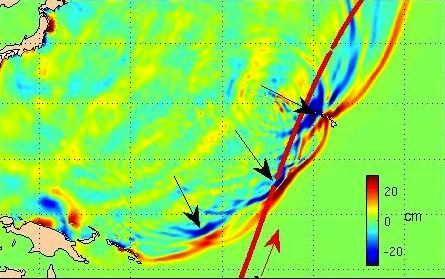Japan's Devastating Tsunami Was a Two-Wave Combo: NASA

NASA researchers have discovered that the devastating March 2011 Japanese Tsunami generated by the Tohoku-Oki earthquake was the result of two merging tsunamis that doubled in power and intensity.
Satellites captured at least two wave fronts at the time of the tsunami, the two wave fronts merged to form a single double-high wave, capable of traveling long distances without losing power.
As a result of the 9.0 magnitude earthquake, ocean ridges and undersea mountain chains pushed the waves together creating a powerful and devastating “merging tsunami,” together killing about 15,840 people.
The observation came as a surprise to researchers as they discussed the findings at a news conference Monday at the American Geophysical Union meeting.
“It was a one-in-ten-million chance that we were able to observe this double wave with satellites,” said Y. Tony Song, scientist at NASA’s Jet Propulsion Laboratory.
“Researchers have suspected for decades that such ‘merging tsunamis’ might have been responsible for the 1960 Chilean tsunami that killed many in Japan and Hawaii, but nobody had definitively observed a merging tsunami until now.”
“It was like looking for a ghost,” he continued. “A NASA/French Space Agency satellite altimeter happened to be in the right place at the right time to capture the double wave and verify its existence.”
C.K. Shum, Ohio State University professor of the Division of Geodetic Science, School of Earth Sciences agreed with Song and said they were very fortunate to have found such information.
“We were very lucky, not only in the timing of the satellite, but also to have access to such detailed GPS-observed ground motion data from Japan to initiate Tony’s tsunami model, and to validate the model results using the satellite data. Now we can use what we learned to make better forecasts of tsunami danger in specific coastal regions anywhere in the world, depending on the location and the mechanism of an undersea quake.”
Satellite Not for Tsunami-Watching
Song explained to Medical Daily that the satellites used in this study were not designed for “real-time” applications. However, “the study suggests that they can be improved for real-time applications in the future.”
He said that although scientists plan on sending out more of these satellites, they are not designed for detecting tsunamis.
“They are designed to measure sea-level rise, for example, for long-term periods.”
Improving Forecasts
The findings allow researchers to better understand and forecast tsunamis.
“The findings tell us how tsunami mergers into destructive waves over the open ocean,” said Song.
“By knowing these, scientists can forecast tsunami better and avoid unnecessary evacuations and panic of coastal communities.”
Published by Medicaldaily.com



























